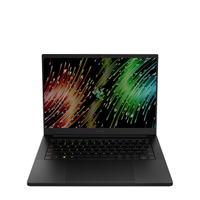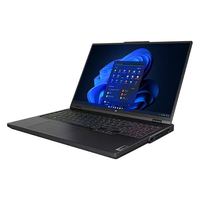If you want pure performance, there are better gaming laptops. But for sheer versatility, not to mention excellent build quality, the 2-in-1 convertible Asus ROG Flow X13 nails it. The only catch is disappointing battery life.
Pros
- +
Slick, compact chassis
- +
Vivid 13.4-inch display
- +
Solid all-around specs
Cons
- –
Slim chassis limits performance
- –
165Hz display doesn’t help battery life
Why you can trust TechRadar We spend hours testing every product or service we review, so you can be sure you’re buying the best. Find out more about how we test.
Asus ROG Flow X13: Two minute review
Asus has updated its natty little 13-inch 2-in-1 convertible laptop, the Asus ROG Flow X13, with the very latest available hardware. That means AMD‘s fabulous Phoenix APU architecture in its full Ryzen 9 7940HS spec with eight CPU cores and a pretty powerful integrated GPU.
However, you can also opt for one of three Nvidia dedicated graphics chips, the GeForce RTX 4050, 4060, or 4070 mobile GPUs. Whichever graphics solution you go for, it outputs to a 13.4-inch display, in this case with a 2,560 by 1,600-pixel resolution and 165Hz refresh, though a 1080p option is available. It’s a touch-enabled display with a 360-degree hinge that supports various modes including tent and tablet.
If that’s not good enough, you can also opt for an even more powerful GPU via the Asus XG Mobile external graphics box that hooks up courtesy of a dedicated I/O port. The laptop itself is packaged into a very slick 1.3kg 13-inch chassis that’s beautifully built, feels very high quality, and is absolutely rigid, including virtually no keyboard bounce. The Asus ROG Flow X13 isn’t exactly cheap, but you can certainly feel where the money has gone.
If there is an obvious catch, it’s that the slim proportions do put a cap on absolute proportions. Our review unit runs an RTX 4060 capped at 60W and 1,470MHz, both much lower than Nvidia normally allows for the chip.
Add in USB4 connectivity and you have a versatile overall package and an intriguing alternative to perhaps the most obvious competition, the Razer Blade 14, which lacks 2-in-1 convertible functionality.
Asus ROG Flow X13: Price and availability
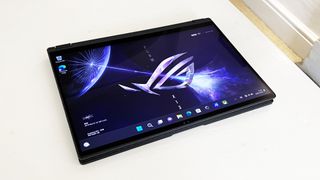
- How much does it cost? $1,699 / £1,699 / AU$2,699
- When is it available? Available now
- Where can you get it? US, UK, and Australia
Available as configured here for $1,699, Asus ROG Flow X13 looks like a pretty good deal for a very high-quality 13.4-inch ultraportable with AMD’s Ryzen 9 7940HS and an Nvidia RTX 4060 GPU, plus 16GB of RAM and a 1TB SSD.
It doesn’t look too bad in the UK, either, at £1,699. In both cases, that’s less than you’ll pay for a similarly specced Razer Blade 14. For the record, the Asus ROG Flow X13 as reviewed here is yours for $2,699 AUD in Australia, which again looks appealing given the quality and the spec on offer.
- Value: 4 / 5
Asus ROG Flow X13: Specs
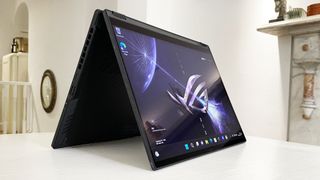
Swipe to scroll horizontally
| Header Cell – Column 0 | Review configuration |
|---|---|
| Price | $1,699 / £1,699 / AU$2,699 |
| CPU | AMD Ryzen 9 7940HS |
| GPU | Nvidia RTX 4060 8GB |
| Memory | 16GB DDR5 |
| Storage | 1TB PCIe SSD |
| Display | 13.4-inch, QHD+ (2560 x 1600), IPS, 165Hz, 3ms, 100% DCI-P3) |
| Ports | 1x USB4, 1x x USB-A, 1x HDMI, 1x microSD, 1x 3.5mm audio, 1x XG Mobile |
| Wireless | Wi-Fi 6E, Bluetooth 5.3 |
| Camera | 1080p webcam |
| Weight | 1.3kg (2.87 lbs) |
| Dimensions | 29.9 x 21.2 x 1.87 cm (11.77 x 8.35 x 0.74 inches) |
Asus ROG Flow X13: Design
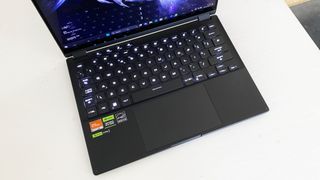
- Gorgeous build quality
- Slim proportions
- 2-in-1 convertible functionality
Asus’s ROG laptops tend to be nicely put together and the Asus ROG Flow X13 (2023) is no exception. It’s not the thinnest 13-inch laptop on the planet, but given it can be had with up to an RTX 4070 GPU, it is pretty slim and certainly very slick.
The chassis is mostly metal and extremely rigid, with zero bounce from the keyboard. The chassis top and screen enclosure also sport appealing textured finishes that feel great in the hand. It’s a seriously high-quality laptop.
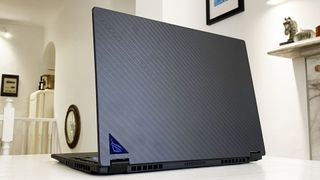
That extends to the 360-degree hinge, which has just the right amount of stiction. Of course, if you want regular tablet functionality, then a dedicated tablet will always be a better option. But the ability to flip the screen right around is definitely handy.
Similarly, the screen’s slim bezels keep things pretty compact while allowing for a 1080p webcam in the top bezel. It’s all very nicely thought out and makes for a very versatile laptop.
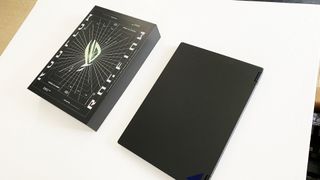
The slim proportions do tend to limit connectivity and the Asus ROG Flow X13 (2023) probably has just enough ports, but no more. You get a USB4 port which doubles as the charging socket, a full-sized HDMI port, one USB-A, microSD, headphone jack and then Asus’s XG Mobile IO port, which supports not only a powerful external GPU, but via the XG Mobile box also adds HDMI, DisplayPort, three USB-A ports and a Type-C socket.
- Design: 4.5 / 5
Asus ROG Flow X13: Performance
- Impressive specs
- Strong CPU performance
- Slim chassis limits frame rates
The combination of an AMD Ryzen 9 7940HS CPU with an Nvidia RTX 4060 mobile GPU is quite the combo for such a compact, versatile laptop. This isn’t an out-and-out gaming laptop, but more an ultraportable 2-in-1 convertible with great build quality and some gaming chops.
With that in mind, expectations need to be kept in check. That’s especially true when you consider that the RTX 4060 GPU is limited to 60W of power. That means the 4060’s clock frequency is capped at 1,470MHz, which is the lowest Nvidia allows and far below the maximum 2,370MHz the 4060 can achieve in some laptops.
Asus ROG Flow X13: Benchmarks
Here’s how the Asus ROG Flow X13 performed in our suite of benchmark tests:
3DMark: Night Raid: 45,567 ; Fire Strike: 16,013 ; Time Spy: 7,430
GeekBench 6: 2,603 (single-core); 11,312 (multi-core)
Total War: Warhammer III (1080p, Ultra): 52 fps; (1080p, Low): 148 fps
Cyberpunk 2077 (1080p, Ultra): 51 fps; (1080p, Low): 104 fps
Dirt 5 (1080p, Ultra): 59 fps; (1080p, Low): 121 fps
TechRadar Battery Life Test: 6h 54m
The consequence is lower frame rates than some more purely gaming-focused laptops with the 4060, such as the Razer Blade 14, which offers the full 2,370Mhz spec. You’ll still get playable frame rates of around 60fps at 1080p in the latest games at ultra settings, provided you don’t run high levels of ray tracing. That said, the RTX 4060 does of course have the full suite of NVIDIA DLSS features – including upscaling from FHD to the QHD+ output of the Flow X13’s display.
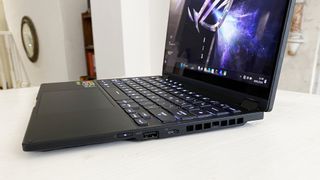
That’s handy because it makes playing games at the Flow X13’s 2,560 by 1,600 pixel native resolution achievable. Without DLSS, that wouldn’t be very realistic with an RTX 4060, which would be a pity given that the display is a lush IPS item running at 165Hz. It’s a great-looking panel, albeit one that can’t compete with an OLED display for contrast and black levels.
Elsewhere, the AMD CPU provides all the performance you could reasonably ask for from this class of laptop, while the 16GB of RAM and 1TB M.2 SSD should cover most needs. There’s an option to upgrade to 32GB if you need really major amounts of memory.
- Performance: 3.5 / 5
Asus ROG Flow X13: Battery life
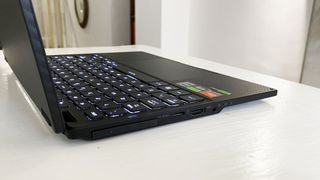
- Efficient AMD APU
- 165Hz display compromises battery life
An efficient AMD APU plus a 75WHr battery in a compact chassis is a promising combination. In practice, however, battery life is not a strong point with the Asus ROG Flow X13 (2023) not quite clocking up seven hours in our fairly undemanding video playback test with the screen at half brightness.
Crank up the brightness or attempt to do anything remotely intensive and that figure will only fall. In other words, the Asus ROG Flow X13 (2023) certainly doesn’t come close to offering all-day battery life even for light tasks, which is a little disappointing for a laptop that prides itself on portability.
- Battery Life: 3.5 / 5
Should you buy a Asus ROG Flow X13?
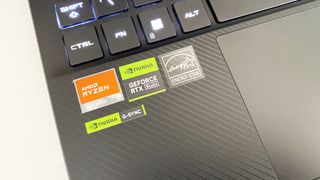
Buy it if…
You want a versatile machine
With the 2-in-1 convertible form factor, plus decent gaming performance, the Asus ROG Flow X13 (2023) does just about everything.
You appreciate great build quality
The Asus ROG Flow X13 (2023) is beautifully engineered with a super rigid chassis and absolutely top-notch materials throughout.
